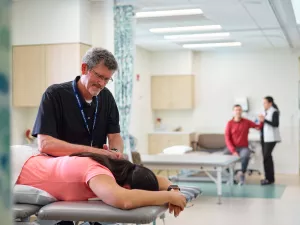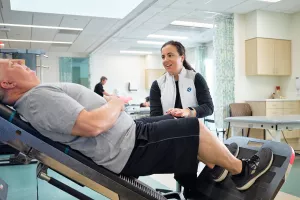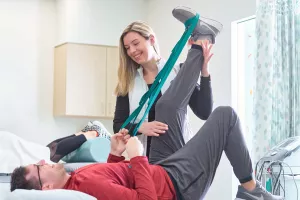Back and neck pain can range from mild aches to severe discomfort that can impact your quality of life. At Tufts Medicine, we can help you find relief from back and neck pain with at-home remedies and teach you ways to prevent it in the future.
We’ve always got your back
Whether it’s a dull ache or a shooting pain, no one likes dealing with back and neck discomfort. It makes important everyday tasks like sitting, exercising and working much more difficult.
The good news is, most neck and back pain can be managed at home with a few changes to your habits and routine, like stretching and over-the-counter medications. And if the pain persists, we can connect you with our expert physical therapy team, who’ll use the latest techniques to help you feel like yourself again.

Conditions
Back and neck pain can be a symptom for a variety of conditions, like:
Types of back pain
The type of back pain you have is based on the amount of time that you’ve been dealing with it.
- Acute back pain lasts for 4 weeks or less. Acute back pain often goes away on its own, or with small changes to your daily routine.
- Subacute back pain lasts for 4–12 weeks. Medication and physical therapy are common approaches for providing relief.
- Chronic back pain lasts for 12 weeks or longer. While this type of back pain can be lifelong, your doctor can create a treatment plan to manage symptoms.
Types of neck pain
There are 2 primary types of neck pain:
- Axial pain is mostly felt in the part of the spine that belongs to the neck.
- Radicular pain is often described as a “shooting” pain, and it’s usually caused by nerve irritation.
Treatments
Most back and neck pain can be treated from the comfort of your home. A combination of stretches, exercises and over-the-counter medications can provide relief. It's important to talk with your primary care doctor about any back or neck pain you're living with.
If at-home remedies aren’t helping to resolve your back or neck pain, physical therapy may be the right treatment for you. Your physical therapist will work together with you to create a treatment path tailored to your needs.
At-home exercises for back + neck pain
When your back or neck hurts, you may not feel motivated to move. Low-impact exercises like stretching for just a few minutes a day is one of the best ways to ease pain and prevent future discomfort.
Remember to ease into your stretching routine slowly, and stop if the pain gets worse. Try out some of these simple methods for back and neck pain relief. If these strategies aren’t working for you, or the pain lasts longer than 4 weeks, schedule an appointment with your doctor.
Lower back pain exercises
- Lower your body into table position on the floor, with knees hip-width apart and your palms placed flat on the ground beneath your shoulders.
- Let your pelvis droop toward the floor so your back curves downward. Hold this position for 5 seconds.
- Next, round your spine upwards so your back looks like a camel's hump. Hold this position for 5 seconds.
- Do 2 sets of 15.
- Lie on your back with both knees bent.
- Rest your right ankle over the left knee.
- Grasp the thigh of the left leg and pull toward your chest. You will feel a stretch along the buttocks and possibly along the outside of your hip. Hold the stretch for 15 to 30 seconds.
- Repeat the exercise with your left ankle over your right knee. Hold the stretch for 15 to 30 seconds.
- Do the exercise 3 times with each leg.
- Lie on your back with your knees bent and your feet flat on the floor.
- Draw in your abdomen and tighten your stomach muscles.
- With your hands stretched out in front of you, curl your upper body forward until your shoulders clear the floor. Hold this position for 3 seconds. (Tips: Don’t hold your breath during the exercise. It helps to breathe out as you lift your shoulders.)
- Relax and lower your shoulders to the floor. Repeat 10 times, with the goal of eventually completing 2 sets of 15.
- To challenge yourself, clasp your hands behind your head and keep your elbows out to your sides.
- Lie on your back with your knees bent and your feet flat on the floor.
- Pull your belly button in towards your spine and push your lower back into the floor, flattening your back.
- Hold this position for 15 seconds, then relax.
- Repeat 5–10 times.
- Lower your body into table position on the floor, with knees hip-width apart and your palms placed flat on the ground beneath your shoulders.
- Pull in your belly button and tighten your abdominal muscles to stiffen your spine.
- While keeping your abdominals tight, raise one arm and the opposite leg away from you. Hold this position for 5 seconds.
- Lower your arm and leg slowly and change sides.
- Do this 10 times on each side.
You can complete this exercise 2 ways: by placing your heel on the ground or an elevated, stable surface like a stool that's about 15 inches high.
- Start in a standing position.
- Extend one leg in front of you with your heel on the ground (or a stool) and your toes pointed upward.
- Lean forward, bending at the hips until you feel a mild stretch in the back of your thigh. Make sure you do not roll your shoulders or bend at the waist when doing this. You want to stretch your leg, not your lower back.
- Hold the stretch for 15–30 seconds. Repeat with each leg 3 times.
Upper back pain exercises
- Sit or stand with your back against a wall.
- Pressing your shoulder blades into the wall, extend your arms up along the wall so your elbows bend at a 90 degree angle at shoulder height.
- Slowly slide your arms upward as high as you can while keeping your elbows and wrists against the wall.
- Do 2 sets of 8–12.
- Lie on your stomach on a firm surface and place a folded pillow underneath your chest.
- Place your arms out straight to your sides with your elbows straight and thumbs toward the ceiling.
- Slowly raise your arms toward the ceiling as you squeeze your shoulder blades together.
- Lower your arms slowly.
- Do 3 sets of 15. As the exercise becomes easier for you, hold soup cans or small weights in your hands.
- Stand in an open doorway or corner with both hands slightly above your head on the door frame or wall.
- Slowly lean forward until you feel a stretch in the front of your shoulders. Hold 15 to 30 seconds.
- Repeat 3 times.
- Position yourself on the floor like a table, with knees hip-width apart and your palms placed flat on the ground beneath your shoulders.
- Pull in your belly button and tighten your abdominal muscles to stiffen your spine.
- While keeping your abdominals tight, raise one arm and the opposite leg away from you. Hold this position for 5 seconds.
- Lower your arm and leg slowly and change sides.
- Do this 10 times on each side.
You’ll need an elastic tubing resistance band for this exercise.
- Secure the resistance band by closing the middle part of it in a doorframe or wrapping it around an immovable object. Hold 1 end of the band in each hand.
- Sit in a chair, bend your arms 90 degrees, and hold one end of the tubing in each hand.
- Keep your forearms vertical and your elbows at shoulder level and bent 90 degrees.
- Pull backward on the band and squeeze your shoulder blades together.
- Do 2 sets of 15.
- While sitting or standing with your arms by your sides, squeeze your shoulder blades together and hold for 5 seconds.
- Do 2 sets of 15.
- Sit in a chair and clasp both arms behind your head.
- Gently arch backward and look up toward the ceiling.
- Repeat 10 times. Do this several times each day.
- Sit on the floor with your legs out straight in front of you.
- Hold your mid-thighs with your hands for stability.
- Curl you head and neck toward your belly button. Hold for a count of 15.
- Repeat 3 times.
Neck pain exercises
- Sit in a chair, keeping your neck, shoulders and torso straight.
- First, turn your head slowly to the right until you feel your muscles stretch
- Turn it back to the forward position and relax.
- Then turn it to the left.
- Repeat in each direction 10 times.
- Sit in a chair, keeping your neck, shoulders and torso straight.
- Tilt your head so that your right ear moves toward your right shoulder.
- Keep tilting until you feel your muscles stretch.
- Then tilt your head in the other direction so your left ear moves toward your left shoulder. Make sure you don’t rotate your head while tilting or raise your shoulder toward your head.
- Repeat this exercise 10 times in each direction.
- Sit in a chair, keeping your neck, shoulders and torso straight.
- Bend your head forward, reaching your chin toward your chest. Hold for 5 seconds.
- Repeat 10 times.
- Sit in a chair looking ahead.
- Tilt your head back so that your chin is pointing toward the ceiling and then bring your head back to the starting position.
- If this exercise is uncomfortable, try placing your hands behind your neck while you look toward the ceiling.
- Be sure to sit up straight and keep your neck, shoulders and torso straight during the exercise.
- Repeat 10 times.
- Place your fingertips on your chin and gently push your head straight back as if you are trying to make a double chin.
- Keep looking forward as your head moves back.
- Hold 5 seconds.
- Repeat 5 times.
- Sit or stand and clasp both hands behind your back.
- Lower your left shoulder and tilt your head toward the right until you feel a stretch.
- Hold this position for 15 to 30 seconds and then return to the starting position.
- Then lower your right shoulder and tilt your head toward the left.
- Hold for 15 to 30 seconds.
- Repeat 3 times on each side.
- Sit tall with your eyes looking straight ahead and your chin level.
- Place your palm against your forehead and gently push your forehead into your palm. Hold for 5 seconds and release.
- Do 3 sets of 5.
- Sit tall with your eyes looking straight ahead and your chin level.
- Clasp your hands together and place them behind your head.
- Press the back of your head into your palms. Hold for 5 seconds, then release.
- Do 3 sets of 5.
- Sit tall with your eyes looking straight ahead and your chin level.
- Place the palm of your hand at the side of your temple and press your temple into the palm of your hand. Hold for 5 seconds and release.
- Do 3 sets of 5 on each side.
- Lie on your back with your knees bent and your feet flat on the floor.
- Tuck your chin and lift your head about 3 inches off the floor, keeping your shoulders flat on the floor. Hold for 10 seconds.
- Repeat 5 times. Try to work up to holding for 20 or 30 seconds.
- Lie on your right side with your right arm lying straight out.
- Rest your head on your arm, then lift your head slowly toward your left shoulder. Hold for 5 seconds.
- Repeat 10 times.
- Switch to your left side and repeat the exercise, lifting your head toward your right shoulder.
- Get into table position on the floor, with knees hip-width apart and your palms placed flat on the ground beneath your shoulders.
- Look straight down at the floor. Keep your back straight and let your head slowly drop toward your chest.
- Then tuck your chin slightly and lift your head up until your neck is level with your back. Hold this position for 5 seconds.
- Repeat 10 times.
- While sitting or standing with your arms by your sides, squeeze your shoulder blades together and hold for 5 seconds.
- Do 2 sets of 15.
Cold + heat therapy
A mix of cold and heat therapy can help ease pain at home.
For the first 24–72 hours of pain, start out with cold therapy. This can help reduce swelling and inflammation in the area causing you discomfort.
- When applying an ice pack or other form of cold therapy, make sure to place a cloth between your skin and anything frozen to reduce the chance of ice burns.
- Be sure to only apply cold therapy for 20 minutes at a time, no more than 10 times per day.
After swelling has subsided, heat therapy can reduce pain and stiffness. There are 2 types of heat therapy: dry and moist. Dry heat therapy includes electric heating pads and hot water bottles. These methods are often faster and easier to apply. Moist heat therapy includes hot baths, steamed towels or moist heating packs.
Remember to be careful when using heat therapy, and experiment with both heat and cold therapies to find out which works best for you. Give us a call if you have any questions.
Over-the-counter medications
There are many medications designed to reduce back and neck pain, and you can pick them up from your local pharmacy or grocery store.
- Non-steroidal anti-inflammatory drugs (NSAIDs) like aspirin or ibuprofen help with back and neck pain and inflammation. These medications can be obtained without a prescription, but remember to read the label and use as directed.
- Topical rubs are available over the counter and can mimic the sensation of heat and/or cold therapy, giving you relief from back and neck discomfort.
Preventing future back + neck pain
You may be able to protect yourself from future back or neck pain or back pain recurrence by being more aware of your daily body mechanics. Proper body mechanics include:
- Avoiding heavy lifting, if possible
- Changing position frequently when sitting
- Choosing a seat with good lower back support, armrests and a swivel base
- Lifting from your legs and keeping your back straight
- Maintaining a neutral pelvic position (hip bones and pubic bone are aligned)
- Placing a pillow or rolled towel behind your back when sitting
- Placing one foot on a footstool if you are standing for a long time
FAQs
If you work at a desk, we recommend a routine called the "Hedge's 3S's Ideal Work Pattern” — a method created by ergonomics professor Dr. Alan Hedge that alternates between sitting, standing and stretching throughout your shift. During a typical 7.5 hour workday, you should try:
- 5 hours sitting
- 2 hours standing
- 30 mins of movement
- 16 sit-to-stand transitions

From regular office visits to inpatient stays, find the healthcare you need and deserve close to home.

Meet the doctors and care team devoted to supporting you every step of the way along your path to better health.